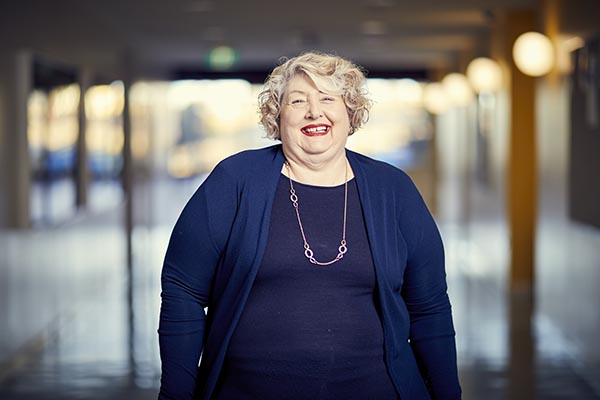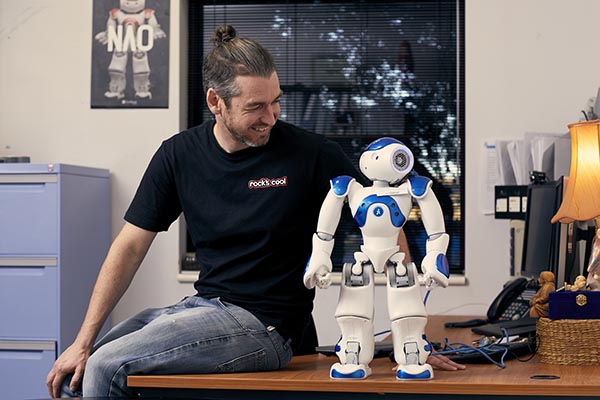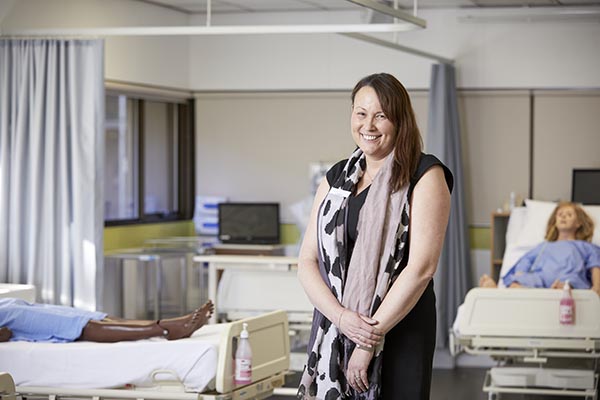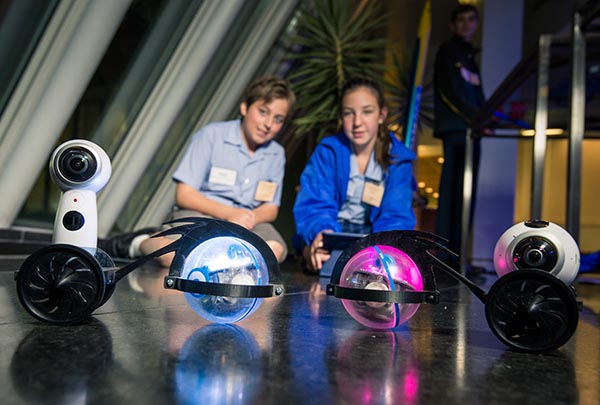Technology in Education: A Whole New World
Technology is sweeping through classrooms as educators move to enhance teaching and the student learning experience.
New technologies like artificial intelligence, machine learning and educational software aren’t just changing the field for students, they’re shaking up the role of educators and creating huge shifts in approaches to teaching. The University of Canberra has embraced technology’s creep into the classroom.
STUDENTS AND ROBOTS COME TOGETHER
Rohan Reece is on autopilot as he nears the end of another long day behind the counter at Mizzuna, the popular cafe he manages at the University of Canberra’s Bruce campus. He’s calling out names for coffees while applying the finishing touches to other orders, the day’s labour splattered across his plain t-shirt. For Mr Reece, the work is second nature – even if it is merely a means to an end. A day earlier, he received confirmation he’d met the final requirements of his undergraduate degree in contemporary music.
The conversation turns from his time studying at the University to the future. Mr Reece is currently a barista by day and a musician by night. He dreams of making a living out of the latter, not only is it where his true passion lies but he wants to inoculate against the looming threat of artificial intelligence. Global management consulting firm McKinsey estimates more than a fifth of the global labour force – 800 million workers – might lose their jobs because of automation – an alarming claim for any worker, not least someone only just entering the workforce.
Mr Reece believes musicians are less at risk than baristas of being superseded by machines. It’s an assessment he’s qualified to make. He has seen first-hand the software at work in hospitality as well as on stage in the form of Ziggy Nao, a pint-sized robot listed as a working staff member at the University. Ziggy Nao is the brainchild of Senior Management Lecturer Diane Phillips and has been programmed to undertake tasks including that of an executive assistant, greeting customers at Mizzuna and musical performances. 
Ms Phillips insists Ziggy Nao doesn’t exist to replace humans in the workforce, but merely as a reminder of what people can expect to work alongside as technology and artificial intelligence become more pervasive in the workforce. “We are the only university in Australia to have a working robot as a staff member and like other staff, he is here to help students do their best,” Ms Phillips said. “I’m trying to get my students used to working with something they will encounter in the future workforce.”
Automation is expected to have a far-reaching impact on the global workforce as employers look to increase productivity and cut costs. Ms Phillips said students had embraced having Ziggy Nao working alongside them, with many reporting his presence as having a positive influence on their own motivation levels and desire to succeed. Students, Phillips says, are wary of becoming complacent. 
“It’s about staying ahead of industry needs,” she said. “We know artificial intelligence is going to have an increasing impact on the workforce in the years to come and it’s important that we prepare students as best we can. They need to be thinking about how they can reinvent themselves and improve their skillset to become irreplaceable.”
AI SPEARHEADS NEW SERVICE MODEL
The University’s push into artificial intelligence is not just limited to the learning experiences of students. Earlier this year, two chatbots were deployed to help students and staff based at its Bruce campus get faster access to information. The two bots – Lucy, aimed at students, and Bruce, for staff – were developed using Microsoft Azure’s Bot Framework, QandA Maker and LUIS natural language service.
Rebecca Armstrong, Deputy Director of Projects at the University, said the initiative was aimed at providing innovative new support channels for students and staff. “The chatbot additions are part of University of Canberra’s larger Digital Catapult Strategy: first, to promote a digitally-enabled culture and second, to build a digital environment across the institution that is distinctive, seamless, intuitive and convenient,” Ms Armstrong said. Lucy and Bruce provide help and information, ranging from enrolment and class schedules to car parking and student services, based on content within the University’s website and intranet. If Lucy can’t find an answer, she will raise a ticket with the Student Centre team to receive a response. The University is also exploring how it might be possible for Bruce to raise support requests with the organisation’s IT service desk.
Lucy has answered almost 1,000 questions since going live in February, while Bruce has handled more than 1,500 since January. While Bruce and Lucy are still learning, the University hopes to enhance its chatbot experience and streamline interactions with staff and students in the future, with more bots and additional features.
MIXED REALITY IMPROVING PATIENT CARE
Nursing students at the University are benefiting from new technology that is changing the way they are preparing to treat patients. In 2017 the University introduced mixed reality devices to help students conduct visual assessments using holographic patients in an Australia-first trial. The technology allows students to interact with holographic patients projected into the classroom via a Microsoft HoloLens. The technology can be used to augment nursing courses and provides students with the chance to explore complex patient scenarios.
Second year nursing students have been using the technology to boost their understanding of physical assessment. They are unable to physically touch the patient, meaning they must rely on other skills to provide a proper assessment. The University’s Deputy Head of Nursing, Associate Professor Jane Frost, said the technology enhances both the learning experience of students and prepares them for clinical practice. “Using a holographic patient that displays various symptoms and behaviours allows students to learn assessment and clinical reasoning skills,” Dr Frost said.
“Being able to walk around the hologram and view the patient from 360 degrees gives an added dimension to the experience. You can’t touch the hologram or take vital signs – you’re actually relying on what you’re seeing.”
Dr Frost said the technology complemented other experiences offered throughout the nursing degree, including working with manikins and Mask-Ed™, a teaching method in which educators wear silicone props to play a character relevant to the lesson. 
“HoloLens allows students to actually look at a patient and really study the patient and the situation, without offending anybody,”
Dr Frost said. “You're able to get really close to the hologram, you're able to stare at the ear and have a good look at the image of the patient and then use clinical reasoning and judgement to figure out what's going on. It's innovative, its safe, students are learning to notice and interpret important cues. It is a new way of learning.”
TECHNOLOGY KEY TO BETTER RESULTS
Technology-enhanced teaching methods developed by University staff are also improving science and mathematics literacy among young Australians. Researchers from the University’s STEM Education Research Centre (SERC) partnered with Samsung Electronics Australia in 2017 to collaborate on the development of an innovative technology program aimed at inspiring young students to use the latest technological devices to learn about spatial reasoning and STEM concepts.
The project builds on SERC’s previous use of technology to determine the extent to which spatial skills have a sustained impact on overall STEM competence among young Australians.
The project, led by Centenary Professor Tom Lowrie, had two parts: the primary school program looked at spatial-reasoning skills in a dynamic 3D-like world on a smartphone or tablet, while the program for high school-aged students used augmented reality to represent the real world as 3D objects on tablets.
“By using creative activities and innovative programs through cutting-edge technologies, such as digital sensor-based mobile platforms, augmented reality technologies, next generation digital signage and visual display solutions, we hoped to complement traditional classroom learning and engage the students in these subjects,” Professor Lowrie said.
The primary school program involved students in Years 5 and 6, with one cohort swapping regular maths lessons for digital and hands-on activities while a second cohort continued with normal class work. The program led to substantial gains in primary students’ mathematics skills after just six hours of teaching. The experimental group improved their spatial reasoning score by 12 per cent and maths by 20 per cent, while students undertaking normal maths lessons improved their score only slightly. 
Key outcomes of the high school program included an increase in design-process thinking and inquiry-based learning among participating students. “The two programs were quite different in nature, but both showed enormous potential where digital tools were used in really productive ways and were embedded within a rich learning program which enhanced students’ learning,” Professor Lowrie said.
Words by Antony Perry

